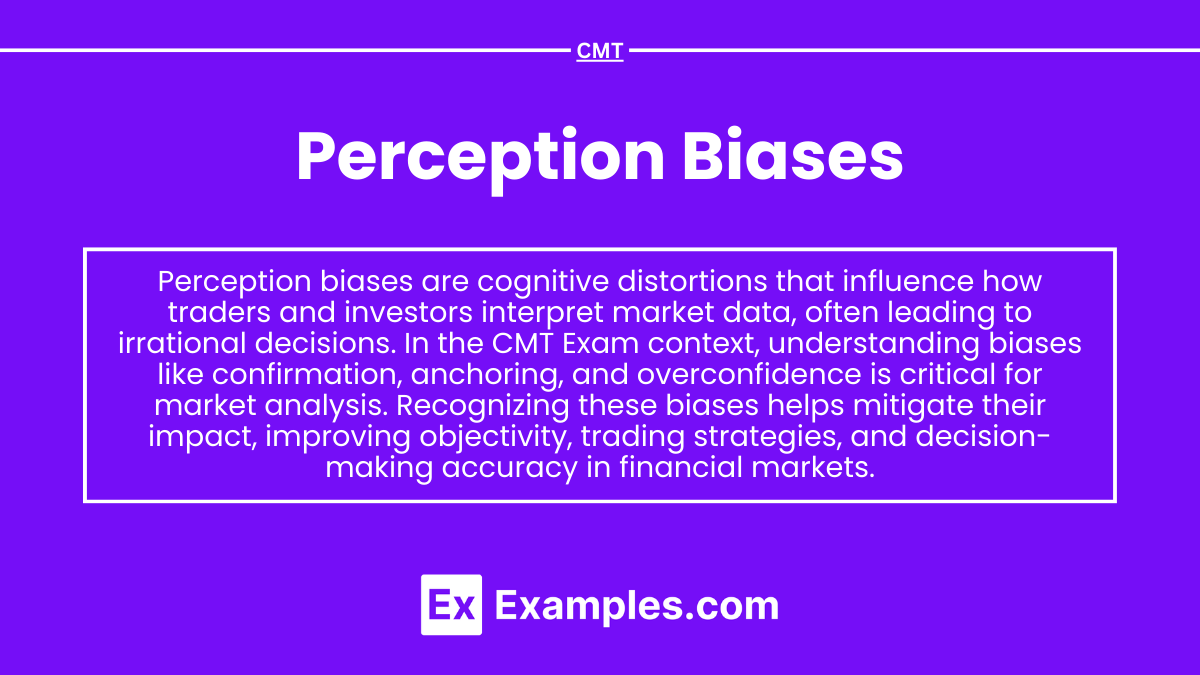Understanding perception biases is essential for the CMT Exam as it influences market behavior and decision-making. Perception biases impact how investors interpret information, leading to distorted views of market trends, risks, and opportunities. Recognizing these biases is critical for developing effective trading strategies and improving analytical skills for accurate market analysis and forecasting.
Learning Objective
In studying “Perception Biases” for the CMT Exam within “Section III: Topics in Behavioral Finance,” you should learn to recognize how cognitive and emotional biases impact the interpretation of market data and trading decisions. Understand key biases such as confirmation bias, hindsight bias, and overconfidence. Analyze how these biases influence market sentiment, decision-making, and price movements. Evaluate strategies to mitigate their effects, improving objectivity and market analysis accuracy. Additionally, explore real-world applications of perception biases in trading scenarios, enhancing the ability to identify irrational market behavior and adapt trading strategies to changing market conditions and investor sentiment.
Introduction to Perception Biases
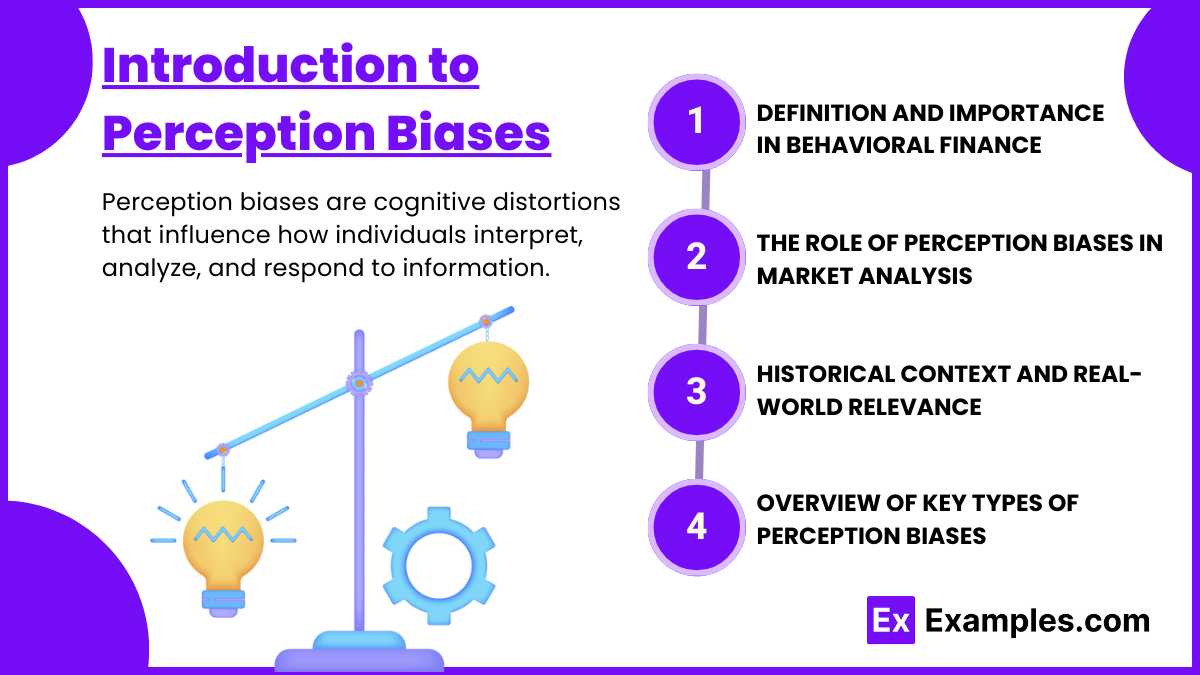
Perception biases are cognitive distortions that influence how individuals interpret, analyze, and respond to information. In the context of financial markets, these biases affect how traders, investors, and market participants perceive market trends, risks, and opportunities. Recognizing and understanding perception biases is crucial for Chartered Market Technicians (CMTs) as these biases often lead to irrational market behavior, creating both opportunities and challenges in market analysis and trading strategies.
1. Definition and Importance in Behavioral Finance
Perception biases are systematic patterns of deviation from rational judgment, leading individuals to interpret information subjectively. In behavioral finance, these biases are crucial as they often drive market behavior and price movements, impacting the efficiency of markets and creating exploitable opportunities.
2. The Role of Perception Biases in Market Analysis
These biases influence how market participants interpret charts, data, and news. For example, a trader may give undue weight to information that supports their pre-existing views (confirmation bias) while dismissing contrary data. Understanding how these biases manifest allows CMTs to better assess market sentiment and trends.
3. Historical Context and Real-World Relevance
Perception biases have historically contributed to market bubbles, crashes, and mispricings. For example, the dot-com bubble was fueled in part by overconfidence and confirmation biases. Recognizing these biases helps in analyzing past market behaviors and predicting future patterns based on similar behaviors.
4. Overview of Key Types of Perception Biases
There are several key perception biases relevant to market behavior, including confirmation bias (seeking information that aligns with one’s beliefs), hindsight bias (believing past events were predictable), overconfidence bias (overestimating one’s abilities), and anchoring bias (relying too heavily on initial information). Understanding these biases enables traders to identify their own blind spots and those of other market participants.
Key Perception Biases in Behavioral Finance
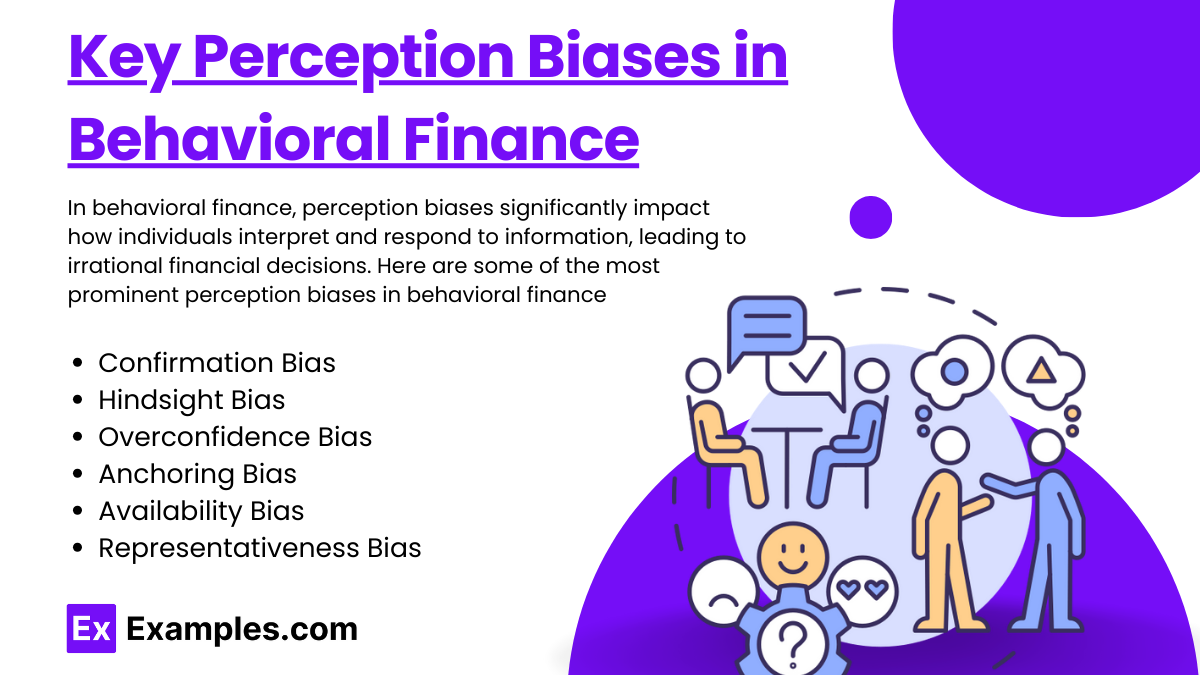
In behavioral finance, perception biases significantly impact how individuals interpret and respond to information, leading to irrational financial decisions. Recognizing these biases is essential for Chartered Market Technicians (CMTs), as they can influence market trends, investor sentiment, and trading patterns. Here are some of the most prominent perception biases in behavioral finance and their impact on market behavior.
1. Confirmation Bias
Confirmation bias is the tendency to search for, interpret, and prioritize information that supports one’s pre-existing beliefs while ignoring or downplaying information that contradicts them. In financial markets, this bias can lead traders to selectively focus on data that aligns with their market outlook, leading to overconfidence in their predictions and potentially reinforcing incorrect assumptions. For example, an investor bullish on a stock may focus on positive news while dismissing warning signs, leading to poor investment decisions.
2. Hindsight Bias
Hindsight bias is the inclination to see past events as predictable and inevitable, even though there was little objective basis for predicting them at the time. This bias leads individuals to overestimate their ability to predict outcomes, creating a false sense of certainty about future events. In trading, hindsight bias can cause investors to believe they “knew it all along” after a market event occurs, potentially leading them to take on more risk than warranted because they feel overly confident in their predictive abilities.
3. Overconfidence Bias
Overconfidence bias occurs when individuals overestimate their knowledge, abilities, or control over events. This is especially prevalent among traders and investors, who may believe they have superior insight or skill, leading them to take on excessive risk or ignore potential downsides. Overconfidence can lead to overtrading, failure to diversify, and disregard for cautionary signals. This bias contributes to market inefficiencies, as overconfident traders may push asset prices beyond their intrinsic values, creating bubbles or sharp corrections.
4. Anchoring Bias
Anchoring bias is the tendency to rely too heavily on the first piece of information encountered (the “anchor”) when making decisions, even if that information is irrelevant or outdated. For example, an investor may anchor on a stock’s past high price, believing it should return to that level despite current market conditions. Anchoring can lead to poor decision-making, as individuals may fail to adjust their evaluations based on new information. In markets, this bias often causes investors to hold onto underperforming assets, expecting them to rebound to previous highs.
5. Availability Bias
Availability bias is the tendency to overestimate the likelihood of events that are more recent, vivid, or memorable. For instance, an investor may overestimate the risk of a market crash after hearing about recent downturns or witnessing media coverage of significant market drops. This bias can lead to irrational risk aversion or excessive caution, potentially causing investors to miss profitable opportunities or overly hedge their positions.
6. Representativeness Bias
Representativeness bias occurs when individuals assess the probability of an event by comparing it to an existing stereotype rather than evaluating it based on relevant data. In finance, traders may assume that patterns in stock prices will continue simply because they resemble previous trends, leading to faulty conclusions and investment decisions. For example, seeing a rapid price increase may lead an investor to believe that a stock is a “growth stock,” even without solid evidence supporting this assumption.
Impact of Perception Biases on Market Behavior
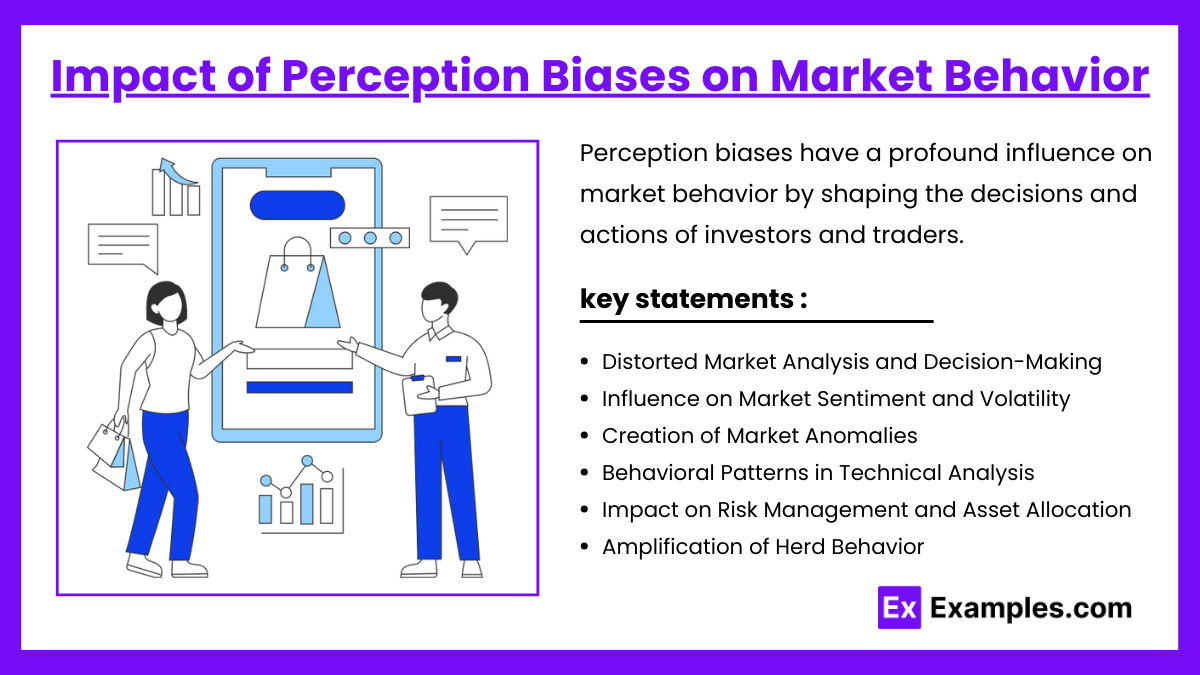
Perception biases have a profound influence on market behavior by shaping the decisions and actions of investors and traders. These biases can lead to irrational decision-making, market inefficiencies, and heightened volatility, often contributing to market trends that may not reflect underlying fundamentals. Understanding how these biases affect market dynamics is essential for Chartered Market Technicians (CMTs) in predicting, analyzing, and responding to market movements.
1. Distorted Market Analysis and Decision-Making
Perception biases can cause market participants to misinterpret data or focus on selective pieces of information. For example, confirmation bias leads traders to seek out evidence that supports their pre-existing views while ignoring contrary data. This can create feedback loops where market trends are reinforced by participants’ biased interpretations, sometimes driving asset prices away from intrinsic values. Misjudged market conditions can lead to poor decision-making and increased risk-taking.
2. Influence on Market Sentiment and Volatility
Investor biases can significantly impact market sentiment, driving collective behaviors that lead to market volatility. For example, hindsight bias may cause traders to believe past trends were predictable, giving them false confidence in predicting future movements. Overconfidence, when widespread, can contribute to speculative bubbles, while loss aversion and panic selling can exacerbate market crashes. The interplay of perception biases often leads to rapid changes in sentiment, fueling sharp price swings.
3. Creation of Market Anomalies
Perception biases contribute to the formation of market anomalies, such as bubbles, crashes, and price distortions. Anchoring bias can cause investors to fixate on outdated price levels, leading to resistance in accepting new market realities. Similarly, the disposition effect (a manifestation of loss aversion) causes traders to hold onto losing positions too long and sell winning ones too soon, creating inefficient market movements and price distortions.
4. Behavioral Patterns in Technical Analysis
Perception biases can also influence how traders interpret technical indicators and patterns. For example, the representativeness bias may lead traders to assume that a particular chart pattern will repeat based solely on superficial resemblance to past trends, without considering the broader context or underlying data. This can lead to overreliance on certain patterns and potential missteps in trading strategy.
5. Impact on Risk Management and Asset Allocation
Biases such as overconfidence and availability bias can lead to flawed risk assessments and suboptimal asset allocation. An overconfident investor may underestimate potential downsides, take on excessive leverage, or fail to diversify their portfolio adequately. Conversely, availability bias can cause disproportionate fear of rare events due to recent memory, leading to overly conservative strategies that miss growth opportunities.
6. Amplification of Herd Behavior
Perception biases often contribute to herd behavior, where investors follow the actions of others rather than making independent decisions. For example, framing bias and social proof can lead individuals to adopt popular trades without adequate analysis. This behavior can create self-reinforcing cycles of asset price inflation or deflation, driven by collective emotional responses rather than rational market analysis.
Mitigating Perception Biases in Trading Strategies
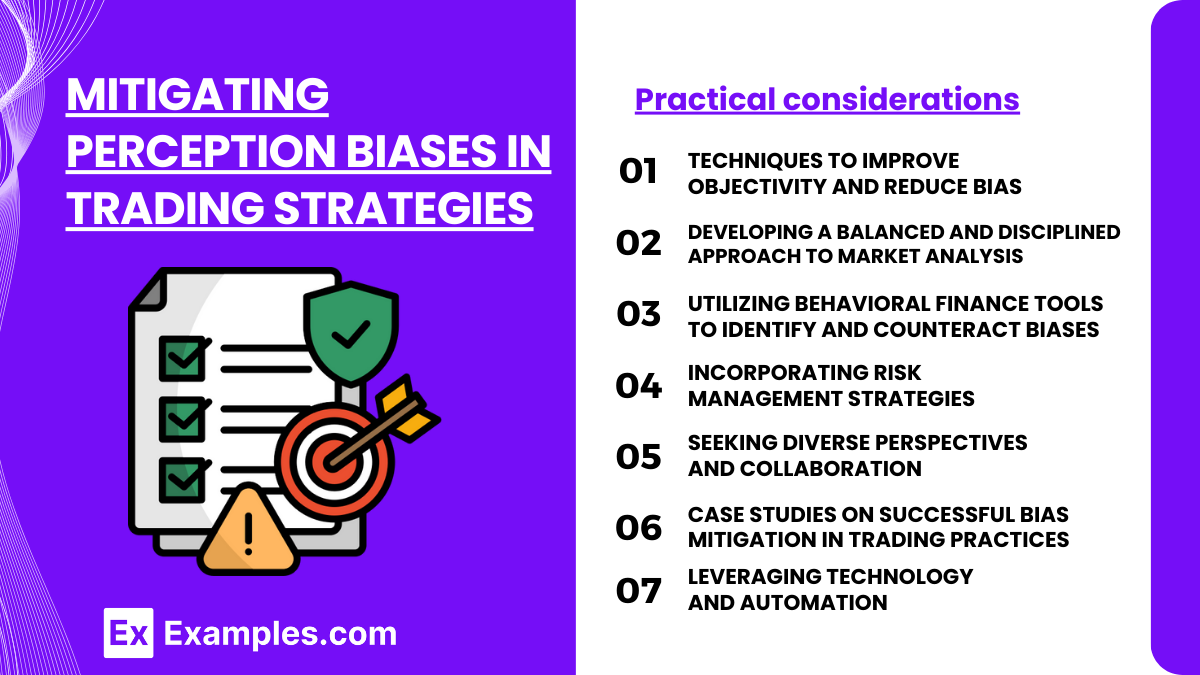
Perception biases can cloud judgment, distort market analysis, and lead to irrational trading decisions. To navigate the complexities of financial markets effectively, Chartered Market Technicians (CMTs) must develop strategies to identify, mitigate, and overcome these biases. By doing so, traders can improve decision-making accuracy, manage risk more effectively, and achieve greater consistency in their trading performance.
1. Techniques to Improve Objectivity and Reduce Bias
Mitigating perception biases begins with cultivating a disciplined approach to trading. This involves adopting a systematic decision-making process that relies on objective data, clear rules, and established methodologies. By adhering to predefined entry and exit criteria, traders can reduce the impact of emotional reactions and biases, leading to more rational decisions.
2. Developing a Balanced and Disciplined Approach to Market Analysis
A balanced approach to market analysis helps traders avoid overreliance on any single data point or preconceived belief. For example, cross-referencing technical analysis with fundamental and sentiment analysis can provide a more comprehensive market view, reducing confirmation bias. Regularly questioning assumptions and challenging existing beliefs can further promote objectivity.
3. Utilizing Behavioral Finance Tools to Identify and Counteract Biases
Behavioral finance tools and techniques, such as journaling trades and conducting post-trade reviews, enable traders to reflect on their decision-making processes and identify biases in hindsight. Self-awareness is key to recognizing patterns of overconfidence, loss aversion, or anchoring in trading behavior. Implementing these tools helps traders learn from past mistakes and adjust their strategies accordingly.
4. Incorporating Risk Management Strategies
Effective risk management is crucial for mitigating the effects of perception biases. Strategies like diversification, position sizing, and the use of stop-loss orders can help traders limit the impact of emotionally-driven decisions. By setting predefined risk parameters and adhering to them, traders can reduce the tendency to take on excessive risk due to overconfidence or to hold onto losing positions due to loss aversion.
5. Seeking Diverse Perspectives and Collaboration
Engaging with other market participants, analysts, and mentors can provide alternative perspectives, reducing the risk of confirmation bias. Collaboration encourages critical thinking and challenges entrenched views, prompting traders to consider multiple viewpoints and reassess their market outlooks. This can lead to more balanced and informed trading decisions.
6. Case Studies on Successful Bias Mitigation in Trading Practices
Studying examples of traders and institutions that successfully mitigated perception biases offers valuable insights into practical applications. For instance, analyzing how top-performing traders adapt their strategies during periods of market volatility or how they respond to cognitive biases provides real-world lessons on discipline, adaptability, and resilience.
7. Leveraging Technology and Automation
Technology, such as algorithmic trading systems, can help mitigate human biases by removing emotions from trading decisions. Algorithms adhere strictly to predefined rules and criteria, eliminating the influence of subjective perceptions and emotions. By leveraging automation, traders can maintain consistency and discipline in their strategies, minimizing the impact of biases on their trades.
Examples
Example 1: Confirmation Bias in Stock Selection
An investor who believes in the strong future potential of a particular technology stock may only seek out positive news articles and reports about that stock, while ignoring warnings, negative analysis, or declining fundamentals. This selective perception can lead to overconfidence and a failure to reassess their position, potentially resulting in losses if the market turns against their expectations.
Example 2: Overconfidence Bias in Day Trading
A day trader who has experienced a streak of successful trades may become overconfident in their abilities, leading them to take excessive risks or increase position sizes. This bias can result in greater exposure to market volatility and large losses when the market does not behave as anticipated. Overconfidence often blinds traders to the inherent risks of each trade.
Example 3: Anchoring Bias in Price Targets
An investor may become anchored to the past high price of a stock and continue to believe it will return to that level, even when market conditions have fundamentally changed. This attachment to an outdated benchmark can lead to poor decision-making, such as holding onto a losing position far longer than is rational.
Example 4: Availability Bias Following Market Crashes
Following a significant market downturn, such as the 2008 financial crisis, some investors may become overly cautious and hesitant to re-enter the market due to vivid memories of losses. This availability bias leads to a heightened perception of risk and a reluctance to take advantage of recovery opportunities, even when conditions improve.
Example 5: Hindsight Bias in Market Analysis
After a market event, such as a sudden rally or crash, traders often believe that the outcome was predictable and that they “knew it all along.” This hindsight bias can create a false sense of confidence in their ability to predict future events, leading to overconfidence in their trading strategies and ignoring the role of uncertainty and randomness.
Practice Questions
Question 1:
What is the effect of confirmation bias on a trader’s decision-making process?
A. Encourages considering all available data equally
B. Leads to seeking information that aligns with existing beliefs
C. Promotes skepticism about market trends
D. Focuses primarily on historical data over current market conditions
Answer: B) Leads to seeking information that aligns with existing beliefs
Explanation:
Confirmation bias causes individuals to seek out or give more weight to information that confirms their pre-existing beliefs while ignoring contrary data. In the context of trading, this can lead to reinforcing incorrect assumptions or ignoring critical warning signs that contradict one’s outlook. The other options do not accurately describe the effects of confirmation bias.
Question 2:
An investor refuses to sell a stock that has declined significantly, hoping it will rebound. Which perception bias is this behavior most closely associated with?
A. Overconfidence Bias
B. Anchoring Bias
C. Disposition Effect
D. Loss Aversion
Answer: D) Loss Aversion
Explanation:
Loss aversion is a key concept of Prospect Theory, where individuals prefer to avoid losses rather than acquire equivalent gains. The investor’s reluctance to sell the stock at a loss and their hope for a rebound is driven by the fear of realizing a loss. This behavior is consistent with loss aversion. While other biases may play a role, loss aversion is the primary driver in this example.
Question 3:
What does anchoring bias lead market participants to do?
A. Base decisions primarily on emotions
B. Overestimate rare events due to recent exposure
C. Rely too heavily on the first piece of information received
D. Disregard changes in market conditions
Answer: C) Rely too heavily on the first piece of information received
Explanation:
Anchoring bias occurs when individuals rely too heavily on an initial piece of information (the “anchor”) when making decisions, even when new, relevant data becomes available. In trading, this can lead to inflexibility and poor decision-making as market conditions change. The other options do not accurately reflect the nature of anchoring bias.

